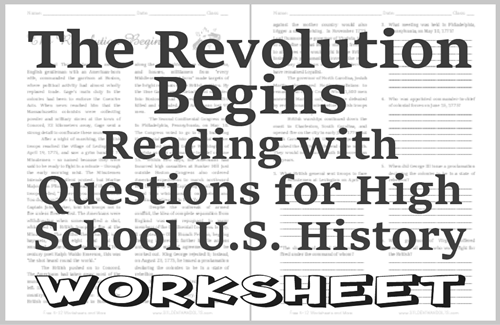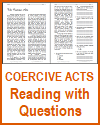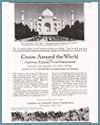| The Revolution Begins Reading with Questions |
|---|
| www.studenthandouts.com ↣ American History ↣ American History Readings |
 General Thomas Gage, an amiable English gentleman with an American-born wife, commanded the garrison at Boston, where political activity had almost wholly replaced trade. Gage's main duty in the colonies had been to enforce the Coercive Acts. When news reached him that the Massachusetts colonists were collecting powder and military stores at the town of Concord, 32 kilometers away, Gage sent a strong detail to confiscate these munitions.
General Thomas Gage, an amiable English gentleman with an American-born wife, commanded the garrison at Boston, where political activity had almost wholly replaced trade. Gage's main duty in the colonies had been to enforce the Coercive Acts. When news reached him that the Massachusetts colonists were collecting powder and military stores at the town of Concord, 32 kilometers away, Gage sent a strong detail to confiscate these munitions.After a night of marching, the British troops reached the village of Lexington on April 19, 1775, and saw a grim band of 77 Minutemen—so named because they were said to be ready to fight in a minute—through the early morning mist. The Minutemen intended only a silent protest, but Marine Major John Pitcairn, the leader of the British troops, yelled, "Disperse, you damned rebels! You dogs, run!" The leader of the Minutemen, Captain John Parker, told his troops not to fire unless fired at first. The Americans were withdrawing when someone fired a shot, which led the British troops to fire at the Minutemen. The British then charged with bayonets, leaving eight dead and 10 wounded. In the often-quoted phrase of 19th century poet Ralph Waldo Emerson, this was "the shot heard round the world." The British pushed on to Concord. The Americans had taken away most of the munitions, but they destroyed whatever was left. In the meantime, American forces in the countryside had mobilized to harass the British on their long return to Boston. All along the road, behind stone walls, hillocks, and houses, militiamen from "every Middlesex village and farm" made targets of the bright red coats of the British soldiers. By the time Gage's weary detachment stumbled into Boston, it had suffered more than 250 killed and wounded. The Americans lost 93 men. The Second Continental Congress met in Philadelphia, Pennsylvania, on May 10. The Congress voted to go to war, inducting the colonial militias into continental service. It appointed Colonel George Washington of Virginia as their commander-in-chief on June 15. Within two days, the Americans had incurred high casualties at Bunker Hill just outside Boston. Congress also ordered American expeditions to march northward into Canada by fall. Capturing Montreal, they failed in a winter assault on Quebec, and eventually retreated to New York. Despite the outbreak of armed conflict, the idea of complete separation from England was still repugnant to many members of the Continental Congress. In July, it adopted the Olive Branch Petition, begging the king to prevent further hostile actions until some sort of agreement could be worked out. King George rejected it; instead, on August 23, 1775, he issued a proclamation declaring the colonies to be in a state of rebellion. Britain had expected the Southern colonies to remain loyal, in part because of their reliance on slavery. Many in the Southern colonies feared that a rebellion against the mother country would also trigger a slave uprising. In November 1775, Lord Dunmore, the governor of Virginia, tried to capitalize on that fear by offering freedom to all slaves who would fight for the British. Instead, his proclamation drove to the rebel side many Virginians who would otherwise have remained Loyalist. The governor of North Carolina, Josiah Martin, also urged North Carolinians to remain loyal to the Crown. When 1,500 men answered Martin's call, they were defeated by revolutionary armies before British troops could arrive to help. British warships continued down the coast to Charleston, South Carolina, and opened fire on the city in early June 1776. But South Carolinians had time to prepare, and repulsed the British by the end of the month. They would not return South for more than two years. Click here to print. Answer Key: (1) Marine Major John Pitcairn, (2) Captain John Parker, (3) Second Continental Congress, (4) Colonel George Washington, (5) August 23, 1775, (6) Lord Dunmore. |
 |  |  |  |  |  |
| www.studenthandouts.com ↣ American History ↣ American History Readings |








